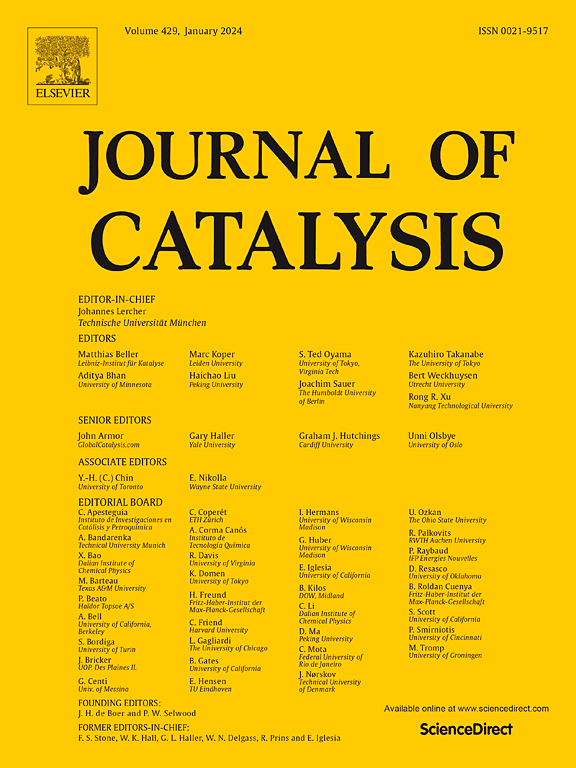CuxIny合金与多金属氧酸盐介质间的选择性质子耦合电子转移工程
IF 6.5
1区 化学
Q2 CHEMISTRY, PHYSICAL
引用次数: 0
摘要
多金属氧酸盐(POM)是一种很有前途的电解质添加剂,可以促进电极/电解质界面上的电催化CO2还原反应(ECO2RR),但POM的质子耦合电子转移(PCET)特性导致的纯金属电极严重氧化仍然不利于ECO2RR。采用一步还原法制备了3种元素比分别为1:1、2:3和1:3的新型CuxIny合金。探讨了制备的合金与keggin型POM (PV2MoW9)之间的PCET行为对ECO2RR性能的影响。在POM介质中,Cu1In3在−0.25 V(相对于RHE)下CO (FECO)的Faradic效率最高,为95.3 %。实验结果表明,PV2MoW9的存在大大提高了反应动力学。原位表面增强拉曼数据显示,PV2MoW9和CuxIny合金之间的连续PCET行为对ECO2RR的性能有很大影响。作为一种“牺牲剂”,最初生成的In2O3有助于Cu原子在合金表面的偏析,从而促进了ECO2RR → CO过程。本工作从电极-电解质相互作用的角度出发,提出了通过合理设计合金元素组成来调整ECO2RR反应途径的新策略。本文章由计算机程序翻译,如有差异,请以英文原文为准。


Selective proton-coupled electron transfer engineering between CuxIny alloy and polyoxometalate medium for efficient CO2 electroreduction to CO
Polyoxometalates (POMs) are promising electrolyte additives to promote the electrocatalytic CO2 reduction reaction (ECO2RR) at the electrode/electrolyte interface, but the pure metal electrode’s severe oxidation caused by POM’s proton-coupled electron transfer (PCET) characteristic remains unfavorable for ECO2RR. Herein, three new CuxIny alloys with different element ratios (1:1, 2:3, and 1:3) were prepared by the one-step reduction method. The effects of PCET behavior between the as-prepared alloys and a Keggin-type POM (PV2MoW9) on ECO2RR performance were explored. Among prepared alloys, Cu1In3 shows the highest Faradic efficiency of CO (FECO) of 95.3% at −0.25 V (vs. RHE) in POM medium. The experimental results suggest greatly enhanced reaction kinetics in the presence of PV2MoW9. In-situ surface enhanced Raman data reveal the highly affected performance of ECO2RR by the sequential PCET behavior between PV2MoW9 and CuxIny alloy. As a “sacrificial agent”, the initially generated In2O3 assists in segregating Cu atoms on the alloy surface, thereby promoting the process ECO2RR → CO. From the perspective of electrode-electrolyte interaction, this work proposes a new strategy to adjust the ECO2RR reaction pathway through rational design of alloy element composition.
求助全文
通过发布文献求助,成功后即可免费获取论文全文。
去求助
来源期刊

Journal of Catalysis
工程技术-工程:化工
CiteScore
12.30
自引率
5.50%
发文量
447
审稿时长
31 days
期刊介绍:
The Journal of Catalysis publishes scholarly articles on both heterogeneous and homogeneous catalysis, covering a wide range of chemical transformations. These include various types of catalysis, such as those mediated by photons, plasmons, and electrons. The focus of the studies is to understand the relationship between catalytic function and the underlying chemical properties of surfaces and metal complexes.
The articles in the journal offer innovative concepts and explore the synthesis and kinetics of inorganic solids and homogeneous complexes. Furthermore, they discuss spectroscopic techniques for characterizing catalysts, investigate the interaction of probes and reacting species with catalysts, and employ theoretical methods.
The research presented in the journal should have direct relevance to the field of catalytic processes, addressing either fundamental aspects or applications of catalysis.
 求助内容:
求助内容: 应助结果提醒方式:
应助结果提醒方式:


